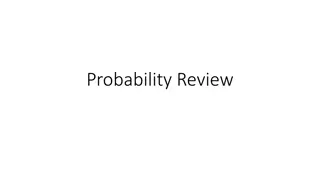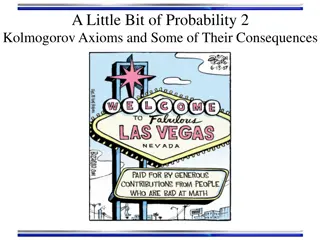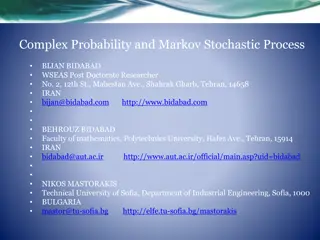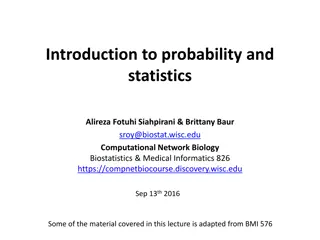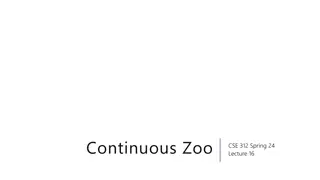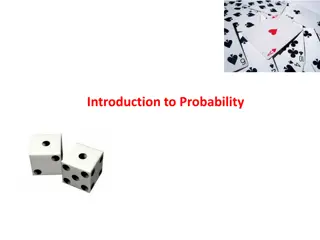Understanding Multi-Stage Probability Experiments
Explore single-stage and multi-stage probability experiments in contemporary mathematics. Learn how to determine sample spaces of experiments using tree diagrams, tables, and outcomes. Discover the concepts of independence and dependence between stages in multi-stage experiments through practical examples.
Download Presentation

Please find below an Image/Link to download the presentation.
The content on the website is provided AS IS for your information and personal use only. It may not be sold, licensed, or shared on other websites without obtaining consent from the author. Download presentation by click this link. If you encounter any issues during the download, it is possible that the publisher has removed the file from their server.
E N D
Presentation Transcript
Contemporary Mathematics Contemporary Mathematics Chapter 7 PROBABILITY
7.4 Tree Diagrams, Tables, and Outcomes 7.4 Tree Diagrams, Tables, and Outcomes Learning Objectives: 1. Determine the sample space of a single-stage experiment. 2. Use tables to list possible outcomes of a multi-stage experiment. 3. Use tree diagrams to list possible outcomes of a multi-stage experiment.
7.4 Single 7.4 Single- -Stage Experiments Stage Experiments A single-stage experiment is one action that has multiple possible outcomes. Experiments have unknown outcomes that generally rely on something random, so that if the experiment is repeated (or replicated) the outcome might be different. The set of possible outcomes is called the sample space. Examples of single stage experiments include: Flipping a coin Drawing a card from a deck Selecting a marble from bag containing marbles of a variety of colors
EXAMPLE EXAMPLE Finding the Sample Space of an Experiment Finding the Sample Space of an Experiment For each of the following experiments, identify the sample space. Flip a coin (which has two faces, typically called heads and tails ) and note which face is up. Let H to denote heads is facing up and T to denote tails is facing up . The sample space is {H, T}. Flip a coin ten times and count the number of heads. The sample space is {0, 1, 2, 3, 4, 5, 6, 7, 8, 9, 10}.
7.4 Multi 7.4 Multi- -stage Experiments stage Experiments A multi-stage experiment has more than one action where each action has multiple possible outcomes. Each action is called a stage. The stages can occur in succession or simultaneously. Examples of multi-stage experiments include: Flipping a coin two times Drawing two cards from a deck one at a time Rolling two dice simultaneously When the stages do not affect each other, we say the stages are independent. Otherwise, the stages are dependent.
EXAMPLE EXAMPLE - - Determining Independence Determining Independence Decide whether the two stages in these experiments are independent or dependent. 1.You flip a coin and note the result, and then flip the coin again and note the result. 2.You draw 2 cards from a standard deck (52 cards), one at a time.
7.4 Multi 7.4 Multi- -stage Experiments stage Experiments Tables are useful for finding the sample space for experiments that meet two criteria: (1) The experiment must have only two stages, and (2) the outcomes of each stage must have no effect on the outcomes of the other, ie. the stages are independent.
7.4 Multi 7.4 Multi- -stage Experiments stage Experiments For example, you re in an ice-cream shop, and you re going to get a single scoop of ice cream with one topping. The flavors of ice cream you re considering are vanilla, chocolate, and rocky road; the toppings are fudge, whipped cream, and sprinkles.
Tree Diagrams Tree Diagrams A bag contains 7 red, 4 blue, and 6 green marbles. Two marbles are drawn from the bag in succession. The color and order in which the balls are drawn is noted. Use the tree diagram below to determine the sample space for possible outcomes. In writing the sample space, use R for red, B for blue, and G for green. The sample space is {RR,RB,RG,BR,BB,BG,GR,GB,GG}
7.5 Basic Concepts of Probability 7.5 Basic Concepts of Probability Learning Objectives: 1. Define probability including impossible and certain events. 2. Calculate basic theoretical probabilities. 3. Calculate basic empirical probabilities. 4. Calculate the probability of the complement of an event.
7.5 Introducing Probability 7.5 Introducing Probability An event is a subset of the sample space of an experiment. The probability of an event is the likelihood that event occurs. We denote the event by ?and call the probability of that event ?(?). The probability of an event is a number between 0 and 1 (inclusive). If ?(?) = 0, then the event is impossible. If ?(?) = 1, then the event is certain to occur. In general, the higher the probability of an event, the more likely it is that the event will occur.
EXAMPLE EXAMPLE Determining Certain and Impossible Events Determining Certain and Impossible Events Consider an experiment that consists of rolling a single standard six-sided die (with faces numbered 1-6). Decide if these probabilities are equal to zero, equal to one, or somewhere in between. 1. ?(roll a 4) Note that 4 is the sample space, so 0 < ?(roll a 4) < 1. The sample space is {1, 2, 3, 4, 5, 6}. 2. ?(roll a 7) Notice that 7 is not in the sample space, ?(roll a 7) = 0
7.5 Three Ways to Assign Probabilities (1 of 2) 7.5 Three Ways to Assign Probabilities (1 of 2) Method 1: Theoretical Probability For an experiment whose sample space ? consists of equally likely outcomes, the theoretical probability of the event ? is the ratio n E ( ), ( ) n S ( ) P E = where ?(?) and ?(?) denote the number of outcomes in the event and in the sample space, respectively.
EXAMPLE EXAMPLE Computing Theoretical Probabilities Computing Theoretical Probabilities Recall that a standard deck of cards consists of 52 unique cards which are labeled with a rank (the whole numbers from 2 to 10, plus J, Q, K, and A) and a suit (club, diamond, heart, or spade). A standard deck is thoroughly shuffled, and you draw one card at random (so every card has an equal chance of being drawn). Find the theoretical probability of drawing a card that is a 10 of spades. 1 52 ( ) of spades = P 10
7.5 Three Ways to Assign Probabilities (2 of 2) 7.5 Three Ways to Assign Probabilities (2 of 2) Method 2: Empirical Probability When we use the outcomes of previous replications of an experiment to find a probability of an event, we re defining an empirical probability. Empirical probability is the ratio of the number of times the event occurred and the total number of repetitions.
EXAMPLE EXAMPLE Finding Empirical Probabilities Finding Empirical Probabilities Assign an empirical probability to the events described below. Jose is on the basketball court practicing his shots from the free throw line. He made 47 out of his last 80 attempts. What is the probability he makes his next shot? Since Jose made 47 out of his last 80 attempts, we can assign this event an empirical probability of 47 80 59%.
The Complement of an Event The Complement of an Event Given an event E, the complement of E is the collection of outcomes that are not in E. We denote the complement of E by E . P(E)=1 P(E')
EXAMPLE EXAMPLE - - The Complement of an Event The Complement of an Event If you roll a standard 6-sided die, what is the probability that the result will be a number greater than one? Here, the sample space is {1, 2, 3, 4, 5, 6}, E={2,3,4,5,6}, and E ={1}. Since E is defined using the inequality roll>1, then E is defined using roll 1. Since there s only one outcome (1) in E', we have P(E )=1/6. P(E)=1 P(E )=1-1/6=5/6















